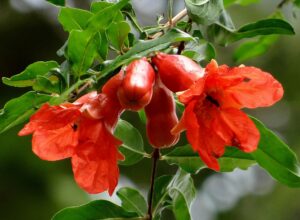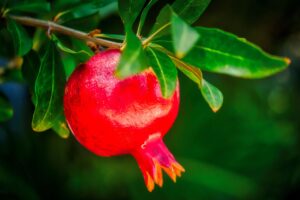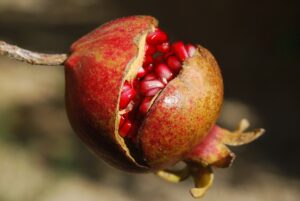B.N. – Punica granatum
Family – Punicaceae
Origin – Iran
Ch. No. – 2n=18 (Basic no. 9 or 8)
Inflorescence – Hypanthodium
Fruit type – Balausta
Edible part – Juicy seed coat
Watch Lecture Video
Important Point
- Daru – Wild type
- Maximum area and production Maharashtra (Area 147.91 thousand hectares and production 1789 thousand metric tons).
- Highest productivity – Tamil Nadu.
- According to the NHB database 2018, the area and production of pomegranate are 234 thousand hectares and 2845 thousand metric tonnes respectively.
- It is a non-climacteric fruit tree.
- Wind (Anemophilous) Pollinated.

Pomegranate flowers - Mix bearing habit.
- The problem of cracking of fruits is more during the Mrig Bahar season.
- Mostly Multistem training system is used in India.
- Highly drought tolerant.
- Pomegranate juice is useful for leprosy patients.
- Summer crop is in maximum demand.
- Covering fruits with butter paper bags protect the fruit from damage by the Anar butterfly (Virachola Isocrates).
- July – August is the ideal time for planting in tropical regions.
- NRC – Pomegranate – Solapur (MH)
Varieties
- Paper shelled
- Muskati Red
- Spanish Ruby
- Alandi
- Karadi
- Muskat

Pomegranate - Madhugiri
- Bassein Seedless
- Dholka
- Jalore seedless
- Chawla
- Nabha
- Country large red.
- Ganesh (GB1) – Selection from Alandi, popular in MH, Developed by Dr. G.S. Cheema
- G-137, G-107, – Clonal selection from Ganesh.
- P-26, P-16, P-13 – Seedling selection from muskat
- Arakta
Hybrid
Mridula – Ganesh x Gul – e -Shah red
Jyoti – Bassein seedless x Dholka
Ruby – Ganesh x Kabul x Yercard
Amlidana – Ganesh x Nanha, Dwaff, TSS 12.60 Brix (IIHR)
Soft-seeded var. – Jyothi, Ganesh, Bassein seedless, Paper shell.
Hard seeded – Khandhari, Alandi
Climate
- It is a tropical plant and grows up to an altitude of 2000 m.
- A hot and dry climate enhances the quality of fruits.
Soil
- Loamy or alluvial soil is best
- Can also be cultivated in slightly alkaline and lime-rich soil.
Propagation
- Pomegranate is commercially propagated by air layering and hardwood cutting.
- Cutting is prepared in North India in spring and in South India in monsoon.
- Air layering is done during the rainy season.
Planting
- Before the onset of the monsoon, pits of 60 to 75 cm are dug at a distance of 4X4m, 3X2.5m, or 4X2m.
- The best time for sowing pomegranate is the monsoon season.
Manure and fertilizers
- FYM – 20 kg/plant
- 240:160:60 grams/plant N:P: K
- Use fertilizers for
- Ambe Bahar – December-January
- Mrig Bahar – May-June
- Hastha Bahar – October-November.
Irrigation
- Give light and regular irrigation during fruiting time.
- Irrigation is required at an interval of 10-12 days till the onset of monsoon.
- Pomegranate can tolerate salt water (500-1000 ppm).
Interculture and Intercropping
- Shallow cultivation should be done to reduce weeds.
- During the first 4 to 5 years, do intercropping with vegetables like cabbage, cauliflower, tomato, peas, beans, etc.
Training and Pruning
-
Multi-stem system
In this case, 3-4 stems are left on each plant and the remaining branches are removed, resulting in the growth of the plant in a bushy form.
-
Single-stem system
All lateral shoots are removed and only one stem is left. The main stem is pinched above a height of about one meter resulting in branching. Only 4-5 branches well distributed on all sides are allowed to grow at a distance of about 60-70 cm from the ground level.
Water sprouts, weak crotch, dead twigs, old spurs are pruned.
Flowering and fruiting
A mature pomegranate plant has a tendency to flower and bear fruit throughout the year.
Bahar regulation/treatment – This is done by withholding water supply 60 days before normal flowering, exposure of the root, and also using chemicals.
- Mrig Bahar – June-July (flowers)
- Ambe Bahar – February – March (flowers)
- Hasta Bahar – September – October (flowers)
Harvesting
- Fruits are ready for harvesting 5 to 7 months after flowering.
- When ripe fruits turn slightly yellow and then pink to red.
- A metallic sound is produced when the fruit is tapped and a ‘crunch’ sound is heard when pressed.
Yield
80-120 fruit/plant or 16-20 kg/plant
Insect-pests
-
Pomegranate butterfly or Anar fruit fly (Virachola isocrates)
The female lays eggs on a cluster of flowers and small fruits. Hatching caterpillars bore inside the developing fruit and are eaten from the inside. Affected fruits fall down.
Control
- Collect and destroy all affected fruits.
- Spray Metacid or Carbaryl 0.2% or Phosphomidon 0.03%
-
Bark Eating caterpillar (Inderbela tetraonis)
The pest bore into the bark of the pomegranate tree and feeding inside.
Control
- Avoid overcrowding of trees by removing unwanted twigs.
- Inject kerosene oil or petrol and plug the hole with cotton wool.
Diseases
-
Fruit rot (Phomopsis sp.)
Flowers in affected plants do not bear fruit and young fruits may drop. Symptoms appear with yellow or black spots all over the fruit.
Control
- Remove and burn all affected twigs, fruits.
- Spray with Dithane Z-78 0.2%
-
Leaf spot (Xanthomonas punicae, Colletotrichum gloeosporioides)
Xanthomonas punica causes irregular water-soaked spots on leaves. They are light brown to dark brown in appearance, with no spots on twigs, branches, or fruits.
Control
- Collect and destroy fallen leaves and fruits.
- Spraying of 0.2% Dithane M-45 or Captan at 15 days intervals.
Physiological Disorder
Fruit Cracking
The cracked fruits are also liable to be invaded by certain fungi and bacteria.
Causes
- Boron deficiency in young plants

Fruit Cracking of Pomegranate - Moisture stress condition created due to irregular irrigation or irregular rains
- Sudden fluctuations in day and night temperatures.
Control
- Spray 0.1% Borax
- The regular supply of soil moisture through light irrigation.
- Plant windbreak around the pomegranate orchard.
- Use resistant varieties.
